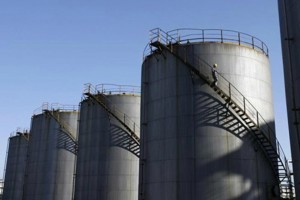After OPEC cuts heavy oil, China teapot refiners pull US supply to Asia
SINGAPORE/HOUSTON (Reuters) -- Chinese independent, or teapot, refiners are bringing in rare cargoes of North American heavy crude in a new long-distance flow that traders say has only been made possible by OPEC's output cuts and ample supplies in Canada and the United States.
In April, at least 1 million barrels of the heavy crude Mars, pumped from the US Gulf of Mexico, are expected to land in China's Shandong province and 1 million barrels of a second unidentified heavy grade will arrive in China, trade and shipping sources said last week. This follows the arrival in January of 600,000 barrels of US Gulf Blend, a heavy crude made up of a blend of various US and Canadian grades loaded onto ships on the US Gulf Coast, according to the sources and shipping data.
Heavy crude is typically denser and more viscous than other oil grades. Refiners with facilities that can process these grades value heavy crude because its lower cost results in higher margins from producing fuels from these grades.
The Organization of the Petroleum Exporting Countries' (OPEC) output cuts have targeted heavy crude, with linchpin producer Saudi Arabia and Venezuela reducing their exports of heavy crude. That has increased the price of Middle East heavy crudes for Asian delivery, making it economical for traders to ship crude from Russia, the Atlantic Basin and the United States to Asia.
"The OPEC cuts started from medium and heavy grades and Venezuela (a key supplier to China) is exporting less," said a Singapore-based crude oil trader.
The tightening heavy crude supplies are occurring at a time when demand for these types has increased after refiners upgraded their plants, the trader said. Heavy crude typically yields a higher%age of residue fuels when first processed at a refinery and that residue is then reformulated into higher-value fuels such as gasoline and diesel fuel in so-called cracking units.
Since late last year, China, the world's second-largest oil consumer, has stepped up imports from North America, one of the few regions where oil production is growing.
Asia's strong pull for heavy sour crude from the Americas led Mars WTC-MRS to hit its highest level in a year relative to North American price benchmark West Texas Intermediate (WTI) as traders forecast increased export demand from Asia.
The Ligurian Sea, a Suezmax tanker, loaded 600,000 barrels of US Gulf Coast Blend from Port Arthur in Texas. The tanker then went around South Africa to arrive at Lanshan port in Shandong in early January after a 55-day journey, shipping data on Thomson Reuters Eikon showed.
The cargo contained Canadian Access Western Blend, a heavy sour grade with an API gravity of about 22 degrees and nearly 4% sulphur, said two trade sources who track oil flows.
Chinese agent Sinoenergy sold the bulk of the cargo to Shandong Tianhong Chemical and the rest went to Shandong Haiyou Petrochemical Group, they said.
The Mars cargo may go to Chinese independent refiner Shandong Wonfull Petrochemical Group, who are close to buying the heavy-sour grade for the first time for April delivery, said a source with knowledge of the proposed deal. The source declined to be named due to company policy.
Wonfull will likely buy the cargo from Swiss trader Trafigura, an active seller of US crude in Asia, said a second trader who closely tracks oil deals in Shangdong.
Castleton Commodities International (CCI) also plans to ship 1 million barrels of an unknown heavy crude grade from the United States to China onboard the Suezmax tanker Erviken which is scheduled to load on Feb. 20, according to one trader, a source in the shipping industry and shipping data.
Sinoenergy, Trafigura, Wonfull, CCI and Haiyou declined to comment. Tianhong could not be reached for comment.
China's largest refiner Sinopec imported heavy crude from the US Gulf late last year, a source with knowledge of the matter said, confirming an earlier Reuters story.
Reporting by Liz Hampton in HOUSTON, Catherine Ngai in NEW YORK, Florence Tan and Mark Tay in SINGAPORE; Additional reporting by Jane Chung in SEOUL and Osamu Tsukimori in TOKYO







Comments